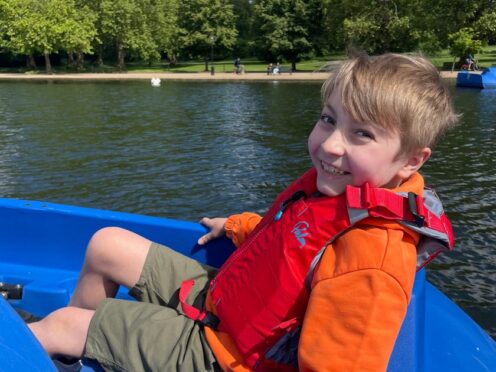A “cutting-edge” test dramatically improves the care of children with cancer and could replace hundreds of other tests, an NHS trial has found.
Experts are so delighted with the findings of a new study into the genetic test they believe it could benefit 1,000 children a year in England alone.
The test, known as whole genome sequencing and available on the NHS, is quicker at giving results than standard tests and offers more benefits than all of them combined, according to researchers at Great Ormond Street Hospital, the University of Cambridge, Cambridge University Hospitals and the Wellcome Sanger Institute.
It works by providing a readout of the entire genetic code of a patient’s tumour and identifies every single cancer-causing mutation.
By pinpointing these genetic mutations, whole genome sequencing enables medics to personalise treatments for patients and work out the chance of cancer coming back.
It can also establish whether cancer runs in families and if siblings are at higher risk.
In comparison, standard tests only look at tiny regions of the cancer genome, meaning children often have to undergo multiple tests.
Dr Jack Bartram, senior author from Great Ormond Street and the North Thames Genomic Medicine Service, told the PA news agency this is the first time the test has been studied in real-time and offered to any child with suspected cancer who walks through the door.
He said the test gives “all of the information up front in a very short space of time”, with results back in as little as 10 days.
Whole genome sequencing could prevent children needing repeat biopsies or any of the 738 standard-of-care tests, according to the research.
Published in Nature Medicine, the study examined data for 281 children with solid tumours and leukaemia, who had biopsies of their tumour or other samples taken.
Whole genome sequencing was found to improve the immediate clinical care of 7% of children, while also providing all the benefits of current standard tests and giving results in a quicker timeframe.
In almost a third (29%) of all cases, genome sequencing also delivered information which went beyond the standard tests.
The team concluded: “Whole genome sequencing faithfully reproduced every standard-of-care molecular test (738) and revealed several previously
unknown genomic features of childhood tumours.
“We show that whole genome sequencing can be delivered as part of routine clinical care to children with suspected cancer and can change clinical management by delivering unexpected genomic insights.”
Dr Bartram said that, at present, medics “keep going” with standard tests such as blood tests and biopsies “until you get the diagnosis and find the genetic driver for a tumour”.
He added: “The beauty of this is that you get all of that information up front so you don’t have to pick from your shopping list of tests.”
In some cases, unexpected mutations were found that increased the risk of cancer in the future, meaning a child may be offered regular scans to check for cancer as they age.
Dr Bartram said one important check was whether siblings were at risk, adding: “Parents often ask, ‘what causes cancer?’ or ‘is my other child at risk?’
“With this (test), you could confidently say (for example) that, of the cancer genes that we know of in 2024, there is no increased risk in the family or in the second child.”
He said that while genomic sequencing has been around for a while, the results of the trial showed the test should now be used routinely in clinical practice.
“Our hope is that every every child has this test carried out at diagnosis across the country so it improves their outcomes,” he said.

Dr Bartram said his team had been “amazed” by the findings, adding: “Our bar is already set very high, certainly at Great Ormond Street and Addenbrooke’s, so our standard of molecular diagnostics is incredibly good and probably up there being the best in the world.
“Our genomics laboratory already offers very advanced DNA sequencing, so even with that, this is above and beyond that.”
Dr Bartram said the NHS’s genomics service is “world-leading” and what patients are now offered is “pretty much unparalleled across the world”.
Professor Sam Behjati, senior author from the Wellcome Sanger Institute, the University of Cambridge and Cambridge University Hospitals, said: “Whole genome sequencing provides the gold standard, most comprehensive and cutting-edge view of cancer.”
Eddie Pessoa de Araujo, from London, now aged nine, had whole genome sequencing while he was under the care of Great Ormond Street.
When Eddie was six, he developed low-grade fevers over several months, before a chest X-ray discovered a huge mass in his chest that was half the size of his lung.
The mass was so big it had moved his heart towards the centre of his chest and he was diagnosed with T-cell acute lymphoblastic leukemia (T-ALL) .
He is now clear of cancer and rang the end-of-treatment bell last week.
His mother, Harri, told PA the family had not hesitated to have the genetic test.
“For us, we wanted as much information as possible about Eddie’s treatment, it was an absolute no-brainer.”
She added: “Having access to whole genome sequencing gave us some sense of reassurance.”
Professor Dame Sue Hill, chief scientific officer and senior responsible officer for Genomics, NHS England, said: “The NHS is the only healthcare system in the world offering whole genome sequencing routinely, including for all paediatric cancers, some adult cancers, and rare diseases – helping us deliver more accurate diagnoses so we can offer more targeted treatment for patients.
“It’s great to see evidence of the benefits of this for children and young people with cancer and we hope this data will lead to more widespread use of it on the NHS, alongside other comprehensive gene panel testing.”
